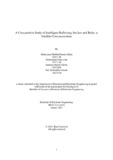A comparative study of intelligent reflecting surface and relay in satellite communication
Abstract
One of the most significant technologies for worldwide telecommunication is satellite
communication. The fundamental advantage of satellites is their extensive range. Low Earth
Orbit (LEO) satellites have the least propagation delay and the best data rate when compared
to other satellite types. Another recent technology being implemented in communication
systems are Unmanned Aerial Vehicles (UAVs). UAVs provide a new dimension to the world
of communication. The principal advantages of UAV are their high mobility and versatility. In
this thesis, we build a communication system consisting of ground base stations, UAVs and
LEO satellites. We then implement two communication schemes in our system and analyze
their performance to find out the better performer. The two communication schemes that are
employed are a Decode and Forward (DF) relay assisted scheme and an Intelligent Reflecting
Surface (IRS) assisted scheme. In our results, we determined that when considering optimum
power transmission and energy efficiency at the same achievable rate, the IRS scheme provided
a much better performance than the DF relay scheme. The results of our thesis conclude that
the IRS scheme is much more superior to the DF relay scheme.

